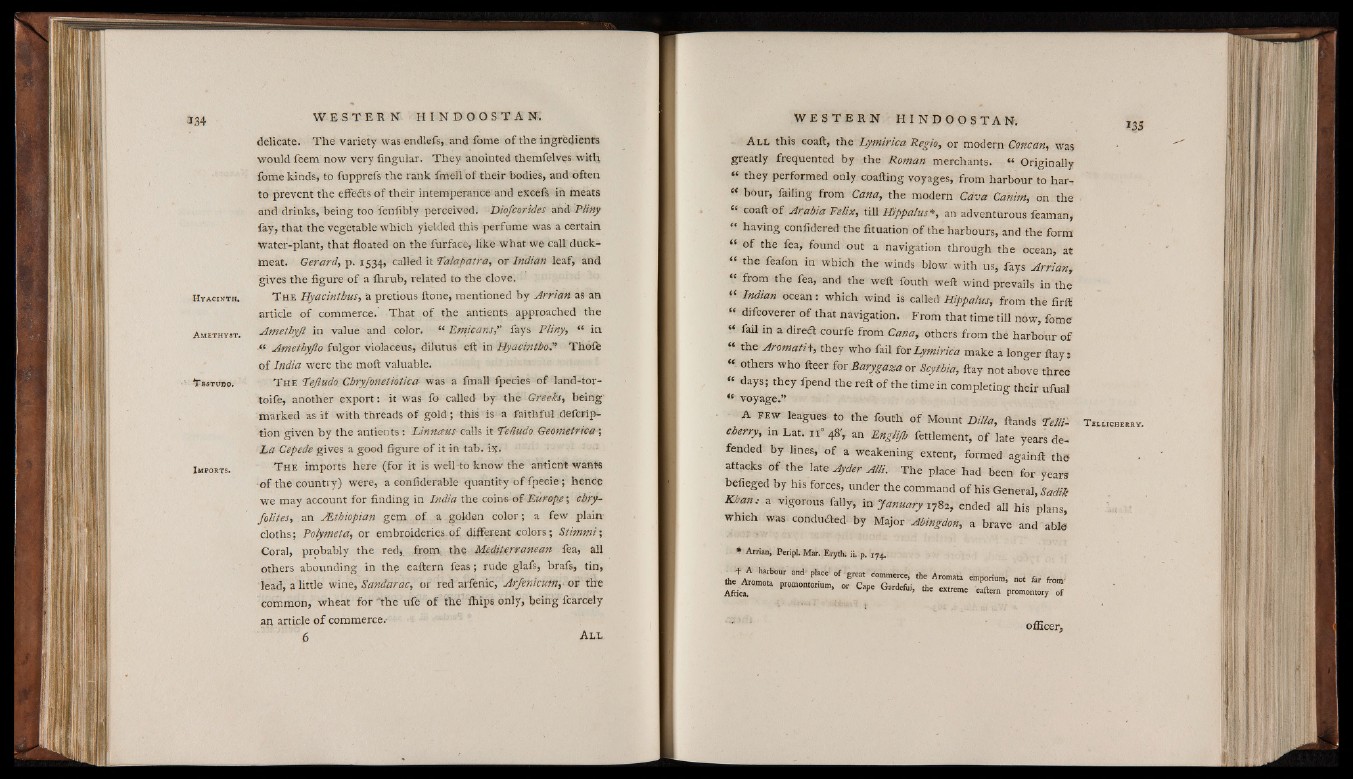
H y a c i n t h .
A m e t h y s t .
^Fb s t it o o .
Imports.
delicate. The variety was endlefs, and fome of the ingredients
would feem now very lingular. They anointed themfelves with
fome kinds, to fupprefs the rank fmell of their bodies, and often
to prevent the effefts of their intemperance and excefs in meats
and drinks, being too fenfibly perceived. Diofcorides and Pltfty
fay, that the vegetable which yielded this perfume was a certain
Water-plant, that floated on the furfaee, like what we call duck-
meat. Gerard, p. 1534, called it Palapatra, or Indian leaf, and
gives the figure o f a Ihrub, related to the clove.
T h e Hyacintbus, a pretious ftone, mentioned by Arrian as an
article of commerce. That o f the antients approached the
Ametbyjl in value and color. “ Etnicans,v fays Pliny, “ in
“ Ametbyjlo fulgor violaceus, dilutus eft in HyacinthoP Thofe
of India were the moft valuable.
T he 'tejludo Chryfonetiotica was a final! fpecies o f land-tor-
toife, another e x p o r t : it was fo called b y the Greeks, b e in g
marked as i f w ith threads o f g o ld ; this is^a fa ith fu l deferift-
tion g iv en b y th e antients: U n n au scalls it I ’e/ludo Geometrica\
La Cepede giv e s a good figure o f it in tab. ix-
The imports here (for it is well to know the antien-t wants
-of the country) were, a confiderable quantity o f fpeeie ; hence
we may account for finding in India the coins of Europe; cbry-
folites, an ^Ethiopian gem of a golden color; a few plain
cloths; Polymeta, or embroideries of different colors; Stimmi\
Coral, probably the red*, from the Mediterranean .fea, all
others abounding in the eaftern feas; rude glafs, brafs, tin,
lead, a little wine, Sandarac, or red arfenic, Arfenicum, or the
common, wheat for The ufe of the lhips only, being fcarcely
art article o f commerce.-
(, A l l
A l l this coaft, the Lymirica Regie, or modern Concan, was
greatly frequented by the Roman merchants. % Originally
“ they performed only coafting voyages, from harbour to har-,
“ bour> failing from Cana, the modern Cava Canini, on the
coaft o f Arabia Felix, till Ftippalus*, an adventurous feaman,
“ having confidered the fituation of the harbours, and the form
“ of the fea, found out a navigation through the ocean, at
“ the feafon in which the winds blow with us, fays Arrian,
“ fr°m the fea, and the weft fouth weft wind prevails in the
“ Indian ocean: which wind is called Hippalus, from the firft
“ difcoverer of that navigation. From that time till now, fome
“ fail in a direft courfe from Cana, others from the harbour of
“ the Aromatii, they who fail ion Lymirica make a longer ftay i
" others who fteer for Sarygaza or Scythia, ftay not above three
“ days; they fpend the reft o f the time in completing their ufual
“ voyage.”
A f ew leagues to the fouth o f Mount Dilla, ftands Telli-
eberry, in Lat. n ° 48', an Fnglijh fettlement, o f late years defended
by lines, o f a weakening extent, formed- againft the
attacks of the late Ayder Alii. The place had been for years
befieged by his forces, under the command o f his General, Sadik
Khan: a vigorous fally, in January 1^ 2 , ended all his plans,
which was condufted by Major Abingdon, a brave and able
» Arrian, Peripl. Mar. Eryth. ii. p. 174.
+aC h a rW and pkce of Ercat commerce, the Aromata emporium, not fir from-
L e t Proin0ni0riUm> “ Cape Gardrfui> * e extreme eaftern promontory of
T e l l i c h e r r y ,
ofGcer,